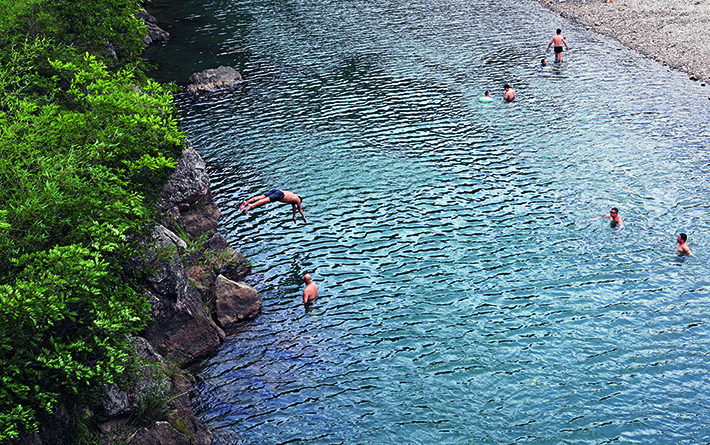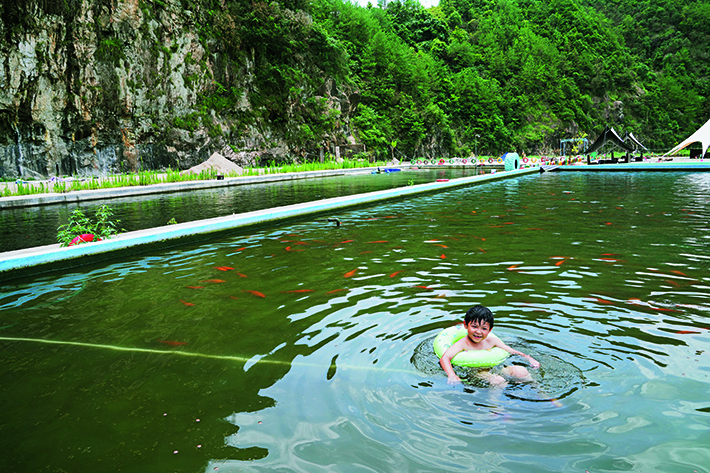|
||||||||||
| Home Nation World Business Opinion Lifestyle ChinAfrica Multimedia Columnists Documents Special Reports |
|
||||||||||
| Home Nation World Business Opinion Lifestyle ChinAfrica Multimedia Columnists Documents Special Reports |
| ChinAfrica |
| Ecological Dividends for the People |
| The river chief system launched nationwide guarantees the effectiveness of water management in the long term, setting a direction for green development |
| By Zhang Juan, Xia Yuanyuan and Ma Li | VOL. 15 September 2023 ·2023-08-30 |

Tourists swim in a creek in Huangcun Township, Lishui City, Zhejiang Province, on 4 July
Every morning, Hong Guoguang walks along the river to check whether there is any sewage being discharged into the water, or if there is any garbage or floating objects in the river. A 5-km river patrol every 10 days is now his routine work.
Hong is the Party branch secretary of Huangfangkou Village in Jizhai Township of Qingtian County, Lishui City in east China’s Zhejiang Province. He is also a village-level river chief. Like Hong, there are more than 50,000 river chiefs in Zhejiang who are engaged in the protection of rivers and lakes on a daily basis.
The river chief system covers the river protection work at the provincial, municipal, county, township and village levels. It was created under the Green Rural Revival Programme proposed by then Provincial Party Committee Secretary Xi Jinping in 2003. The programme’s goal was to build 1,000 model villages and renovate 10,000 villages.
Over the past two decades, 50,000 km of rivers in Zhejiang have taken a new look thanks to the programme. The river chief system has changed the waters from dirty to clean, making a contribution to the building of a beautiful China.
Better water quality
The river chief system was first launched in Changxing County of Zhejiang’s Huzhou City in 2003, and began to be adopted throughout the province 10 years later. Under this system, Party and government leaders at all levels serve as river chiefs, responsible for the work to clean up the polluted waterways and restore the ecosystem.
Jizhai has a waterway running through the entire township, and is home to the Jinkeng Reservoir. However, local villagers used to raise poultry and litter the riverside, which turned the clean river into a garbage ditch. It was a nightmare for the residents of Huangfangkou Village, since it is situated along the river, with many of their houses built near the river bank. “In those days, almost every household kept poultry. The river became dirty and smelly,” said villager Ye Xianghua.
In 2014, the local government of Jizhai Township began a comprehensive clean-up of the river. Key leaders of the township and villages served as river chiefs and led the work of river dredging, pollution control from livestock and poultry breeding, and garbage disposal. The river has transformed from the black smelly water full of floating garbage into a scenic waterway.
“After years of river management, the waters have become clearer and the air is fresher. Now we do morning exercises on the riverside every day,” said Ye.
Balanced growth
In Huangfangkou Village, there is a large grouper farm where dozens of barrels with a diameter of 6 to 8 metres are placed in a sequence. The crystal water from the local river slowly flows into the barrels and the fry swim happily inside. It is one of the fish farming projects which aim to explore ways to protect the environment while driving the economic growth through the utilisation of clean water.
The clean-water fish farming project was launched in Jizhai Township in 2021, with a planned investment of 7 million yuan ($958,900). It was co-funded by a township government-led company and a private breeding base, with investment from local villages. Unlike traditional high-density fertilised-water fish farming, the clean-water fish farming method utilises high-quality tailwater of the Jinkeng Hydropower Station for breeding. Manure or fertilisers are not used in the entire process. The method hence boosts the sound development of both the aquatic environment and fish farming industry.
“We raised more than 400,000 groupers, most of which have been reserved by customers,” said Ye Genyong, manager of the breeding base, adding that the farm is expected to produce 25,000 kg of groupers per year, with annual sales of more than 3 million yuan ($411,000), which can increase the income of the Huangfangkou village collective by 240,000 yuan ($32,877) per year. In the future, an agricultural park featuring “water economy” will be built with indoor fishing and farmhouse entertainment facilities.
The Zhejiang model of utilising water resources, protecting water ecology, and invigorating the “water economy” has built a high-quality water industry that integrates aquaculture, cultural tourism and high-end aquatic products, benefiting local people.

A child plays in a fish farm in the village of Huangfangkou in Jizhai Township of Qingtian County, Lishui City, Zhejiang Province, on 7 July
From beautiful to prosperous
The 120-km green belt along the Songyin Creek’s embankment is a good place for local residents to get close to water. There are also laundry docks, drainage channels and fishing spots. Li Chaosheng, senior engineer of Songyang County’s Water Conservancy Bureau in Lishui City, said that the ultimate goal is to let the public share the ecological dividend of water management.
Flood prevention is a major part of the water governance project in Zhejiang Province. As the largest river in Songyang County, the Songyin Creek has nourished the local residents for thousands of years. However, due to the damage to the ecological environment, the dam on the river has broken several times, damaging farmland and making the water body muddy.
Starting in 2000, Songyang County has reinforced its flood control system, using erosion-resistant materials such as concrete blocks and strip stones. However, the hard concrete dam destroyed the aquatic habitat, badly affecting the survival of aquatic plants on the river bank; and the high embankment structure also blocked the residents’ access to the river. The flood control project received negative comments from the public.
“At that time, people called the city’s flood control embankment an ‘iron wall,’ as it blocked people’s access to the river. Even frogs could not jump ashore anymore,” Li said, noting that they had to readjust the strategy to make the people really benefit from the harmonious coexistence between man and nature.
In the following two decades, the Water Conservancy Bureau in Songyang and local government amended their approach to boost nature rehabilitation. First, they adjusted the design of embankments to build a water system complete with lakes, ponds, beaches, banks and islands, with plenty of space for aquatic habitats. Meanwhile, efforts were made to keep the appearance of the rivers as original as possible.
Nowadays, the flood embankment has taken a new look, serving as the waterfront green belt with areas for people to walk, socialise and enjoy a view of the river.
| About Us | Contact Us | Advertise with Us | Subscribe |
| Copyright Beijing Review All rights reserved 京ICP备08005356号-5 京公网安备110102005860号 |